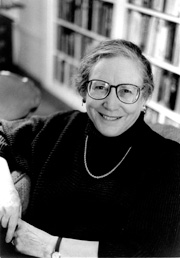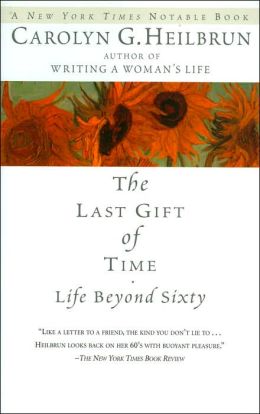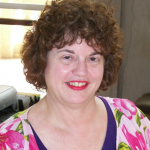"My Favorite Critic" by Emily Toth
Carolyn Heilbrun: Elegant Wit, Fierce Truth
It was at the notoriously fusty Modern Language Association conference in 1984 that Carolyn Heilbrun offered some of the best advice I’ve ever heard.
 She was one of the first women to be elected president of the MLA, and I attended her presidential address that year wanting to cheer her on, but expecting the usual blather: great future, challenges before us all, we need the humanities now more than ever.
She was one of the first women to be elected president of the MLA, and I attended her presidential address that year wanting to cheer her on, but expecting the usual blather: great future, challenges before us all, we need the humanities now more than ever.
Instead, Heilbrun looked feisty, even wearing a conventional dress. (Four years later, at 62, she threw out all her dresses, nylons, and high heels, vowing she’d never again wear “female drag.”) At the MLA, she told us about a little boy who desperately wanted his sister’s barrette. He kept poking and pulling, until finally an exasperated parent told him to stop carrying on about a hair ornament, because “After all, you have a penis.”
“Everybody has a penis!” the little boy cried. “I want a barrette!”
The point of this story was—well, I don’t really remember. But the point for me was that you could say what you thought, even at the MLA, and the earth wouldn’t open up and swallow you and destroy your academic career. You could be a female professor and be outspoken. You could make fun of the phallocrats—a word we threw around a lot in those days.
In short, as an academic-in-training, I learned I could be me.
Carolyn Gold Heilbrun, born in 1926 in East Orange, New Jersey, was an emancipated thinker who wrote a kind of old-fashioned prose, rather like an Edwardian lady. Her sentences were balanced, precise, and genteelly correct. She never split an infinitive or ended with a preposition. But sometimes she’d end with a howler of a snapper, as in her 1988 review in the Women’s Review of Books of a biography of James Joyce’s wife Nora Barnacle. Heilbrun was judicious about the book, but ended one paragraph with the observation that Joyce was “a world class shit.”
I loved it. I also loved her, because of her generosity when we met. It was in the 1970s in New York, when we both served on the MLA Executive Committee. I was one of two junior women, and I think she was the chair, but the loud voices, debating and pontificating and obstructing, came from the other committee members, all men. (One of those phallocrats had been a grad school professor of mine.)
I couldn’t figure out why they were so exercised about whatever-it-was, and the other young female professor, Karen Rowe of UCLA, seemed equally mystified.
Then Heilbrun called Karen and me aside and interpreted the meeting for us. Phallocrat A was mad at Phallocrat B for some past feud, maybe about literary criticism or something more personal. Phallocrats C and D loved the sound of their own voices, and were famous for that. And so on. I still remember her delighted and conspiratorial smile as she explained how the academic world worked.
After that, I never feared the phallocrats, and I looked for mentors among senior women. That one encounter may have changed my life, since thinking about mentoring led me, years later, to create a character called “Ms. Mentor,” who’s published two books of advice for academics and is now in her seventeenth year of writing a monthly column for the Chronicle of Higher Education. Ms. Mentor has Miss Manners’s voice, but Carolyn Heilbrun’s audacity. She makes fun of power.
As a literary critic, Heilbrun also shaped my world. Her 1973 Toward a Recognition of Androgyny, which traces the “hidden river of androgyny” through literature, clued me into seeing Hemingwayesque macho types as not just chest-thumping he-men, but as lost souls seeking the rib, the female part that had been taken from them. Reading Hemingway now, I see vagina envy rather than phallocracy. In the best writers of both sexes I see a curiosity about and tenderness toward the other half.
From Heilbrun’s 1988 book Writing a Woman’s Life, I learned to ask the right questions about unconventional women. Yes, George Eliot had to stay home from parties because she was living in sin with a married man—but being a bad woman gave her the time and intellectual freedom that no respectable wife ever had. As Heilbrun showed, Nest versus Quest is the story of most women’s lives, the conflict that propels or stifles us. In Writing a Woman’s Life, she underscored the way the standard marriage plot wipes women out:
We women have lived too much with closure: ‘If he notices me, if I marry him, if I get into college, if I get this work accepted, if I get this job’—there always seems to loom the possibility of something being over, settled, sweeping clear the way for contentment. This is the delusion of a passive life. When the hope for closure is abandoned, when there is an end to fantasy, adventure for women will begin.
This remarkable critic and biographer taught me to look at women’s lives through women’s eyes—not as the saga of competition and put-downs we’re always taught, but as a celebration of women’s resourcefulness and wit. Heilbrun’s immense generosity of spirit about women reminds me of Gloria Steinem’s writing—and it’s no accident that Heilbrun wrote a 1995 biography of Steinem, Education of a Woman.
Heilbrun's Writing a Woman’s Life also stresses women’s enjoyment: “In the end the changed life for women will be marked, I am certain, with laughter.”
I found less laughter in the academic mysteries she wrote under the pen name Amanda Cross. Her sleuth, Kate Fansler, was an English professor who solved murders, one of the first of scores of such characters. Kate never seemed quite real to me: Her conversation was too archly clever, too mannered. But I should read those stories again, since I’m certainly more arch than I was decades ago.
 Which brings me to The Last Gift of Time: Life Beyond Sixty, Heilbrun’s 1997 celebration and critique of aging. Still married to her husband of nearly half a century, she bought a country house of her own for solitude (the same yearning for a room of one’s own expressed by Virginia Woolf, Doris Lessing, May Sarton, Alix Kates Shulman, and countless others). At 71, Heilbrun wrote about liking the don’t-give-a-shitness about being older. Like me, she was unmoved by nature and loathed anything that’s uncomfortable or needs fixing.
Which brings me to The Last Gift of Time: Life Beyond Sixty, Heilbrun’s 1997 celebration and critique of aging. Still married to her husband of nearly half a century, she bought a country house of her own for solitude (the same yearning for a room of one’s own expressed by Virginia Woolf, Doris Lessing, May Sarton, Alix Kates Shulman, and countless others). At 71, Heilbrun wrote about liking the don’t-give-a-shitness about being older. Like me, she was unmoved by nature and loathed anything that’s uncomfortable or needs fixing.
She also wrote about killing herself, maybe around age 75. “Three score and ten” didn’t seem quite enough, she noted. It would be “leaving the party while it’s still fun…. I find it powerfully reassuring now to think of life as ‘borrowed time.’” Heilbrun wasn’t in bad health then, but thought she might want to check out before she got sick or became a burden.
When she was 77 in 2003, toward the end of a party celebrating her son’s newly published novel Offer of Proof, she went into a back bedroom, left a note saying “The journey is over. Love to all,” put a plastic bag over her face, and died.
I could say I understand it intellectually, but I’m still shocked to write those words. Maybe it was her last gift to us, to get us to see death as a choice. She opened the world to women when she got us to see our lives the way we see them, not the way men judge them. The arch, Britishy voice she used as a writer was something of an impersonation—or maybe a satire. Her background was Jewish, and she was “a peasant, scraped off the Lower East Side,” she wrote in her 1979 world changer Reinventing Womanhood. She was not to the manner born.
Neither am I, but she told me, in her writings and in our few encounters, that I didn’t have to accept the bray of the phallocrat.
After all, he didn’t have a barrette.
Publishing Information
- “Sacrificed to Art” by Carolyn G. Heilbrun (review of Nora: The Real Life of Molly Bloom by Brenda Maddox), Women’s Review of Books, September 1988.
- Toward a Recognition of Androgyny by Carolyn G. Heilbrun (Knopf,1973).
- Writing a Woman’s Life by Carolyn G. Heilbrun (Ballantine/Random House, 1988).
- Education of a Woman: The Life of Gloria Steinem by Carolyn G. Heilbrun (Ballantine/Random House, 1995).
- Death in a Tenured Position by Amanda Cross (Dutton, 1981). The best known of the Kate Fansler books.
- The Last Gift of Time: Life Beyond Sixty by Carolyn G. Heilbrun (Ballantine/Random House, 1997).
- Reinventing Womanhood by Carolyn G. Heilbrun (Norton, 1979).
Art Information
- Photo of Carolyn Heilbrun (Amanda Cross) © Miriam Berkley; used by permission.
 Emily Toth is a contributing writer at Talking Writing, where her column “Nothing but the Toth” appears regularly. She’s also “Ms. Mentor" at the online Chronicle of Higher Education. For a recent Ms. Mentor column, see “My Boss Is Ungrammatical.”
Emily Toth is a contributing writer at Talking Writing, where her column “Nothing but the Toth” appears regularly. She’s also “Ms. Mentor" at the online Chronicle of Higher Education. For a recent Ms. Mentor column, see “My Boss Is Ungrammatical.”
As TW’s doyenne of advice, Emily is the judge for the 2014 Talking Writing Prize for Writing Advice. Please go to the TW Contests page for information about how to enter. Deadline: October 1, 2014.
